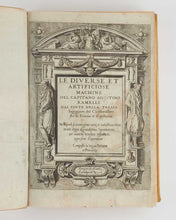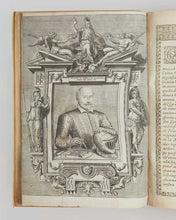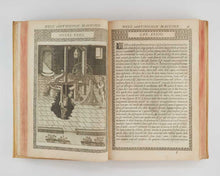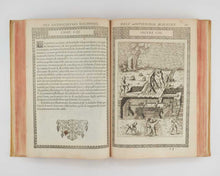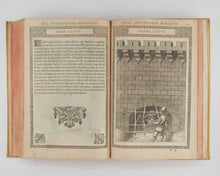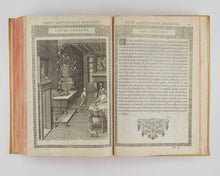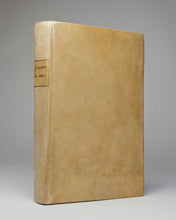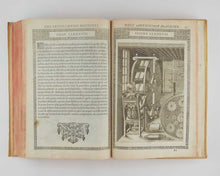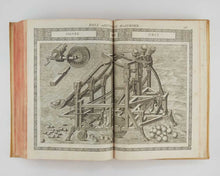
RAMELLI, Agostino. Le diverse et artificiose machine … Nelle qualsi si contengono varij et industriosi Movimenti, degni digrandissima Speculatione, per cavarne beneficio infinito in ogni sorte d’operatione. Composte in lingua Italiana et Francese. Paris: “In casa del’autore”. 1588.
Folio. 20th-century vellum over boards, modern gilt lettering to spine, edges stained red; ff. [16], 338, engraved architectural title page by Léonard Gaultier, engraved portrait of Ramelli by Gaultier to title-page verso, 195 engraved plates numbered I-CXCV (20 of which double-page), text within typographical frames, woodcut initials and tailpieces; recased, extremities lightly rubbed, small marks to boards, small ink stains to edges of textblock; 8.5-cm open tear to outer margin of first leaf, with old paper repair and missing printed surface supplied in ink, occasional marginal staining and light offsetting, occasional tiny wormhole to inner margin (touching only double-page plates), but generally a very good, bright copy; ink annotations by a contemporary hand to verso of final leaf (see below).
First edition of one of the most celebrated illustrated books of the sixteenth century, and “one of the most elegantly produced of all technological treatises” (Norman).
Born near the Swiss-Italian border, Agostino Ramelli (1531-c. 1610) trained in military architecture before joining the army of the renowned condottiero and Spanish general Gian Giacomo Medici (1498-1555). After Medici’s death, he entered the employ of the Duke of Savoy, and by 1565 had relocated to France, where he entered the service of the future Henry III. In 1572, during the siege of La Rochelle, Ramelli was gravely wounded and taken prisoner by the Huguenots. Upon his release, he remained in the French king’s service and, in 1587, was entrusted by Catherine de’ Medici with overseeing the fortification of Paris.
Ramelli’s Le diverse et artificiose machine stands as his magnum opus, renowned for its blend of technical innovation and artistic refinement. The treatise explores the vast potential of mechanical invention and had a profound impact on the development of mechanical and military engineering in early modern Europe, including the work of Grollier de Servière and Jacob Leupold. The work was developed over several years in collaboration with fellow military engineer Ambroise Bachot, and was likely printed in a press installed in Ramelli’s own Paris residence.
Dedicated to Henry III, the volume opens with Léonard Gaultier’s striking portrait of the author: richly attired, seated at a table, helmet in one hand and compass in the other, measuring the plan of a fortress. The book presents an extraordinary array of mechanical inventions: “110 water-lifting machines, 21 grain mills, 4 alternative mill designs, 10 cranes, 7 transport mechanisms for heavy loads, 2 earth-lifting devices, 2 cisterns, 4 fountains, 15 military bridges, 14 screw jacks and other wall-demolishing tools, one artillery mechanism, and more” (DBI, trans.). Many of these are supported by enlarged schematics showing the intricate gear systems that animate them, testament to Ramelli’s meticulous concern for mechanical precision.
Among the 195 plates is the earliest known European depiction of a book wheel (plate CLXXXVIII): a rotating reading desk modelled after a water wheel, designed to allow simultaneous consultation of multiple large volumes. It is often cited as one of the earliest “information retrieval” machines, and was especially recommended by Ramelli for readers “troubled by gout or otherwise incapacitated”, an early nod to accessibility in design. Also featured is an automaton inspired by Hero of Alexandria, comprising a group of birds perched on the branches of a large vase which move and sing when activated by air pressure (plate CLXXXVII).
Plates CXLVIII and CXLIX appear as a single engraving; three others are signed with the cipher “JG”, possibly referring to Jean de Gourmont. A German translation, titled Schatzkammer, Mechanischer Künste, appeared in Leipzig in 1620.
Provenance: An early owner of this copy has inscribed an apparently unpublished love poem on the verso of the final leaf, beginning: “La fontaine qui long voudra croissir en quelque lieu que long…”.
Adams R-52; Brunet, IV, 1095 (“Cet ouvrage, écrit en italién et en franςais, est rare et recherché”), Dibner Heralds 173 (“The engravings are among the best in technological illustration”); Norman 1777 (“The plates in Ramelli’s treatise are artistically as well as technologically superb, the bilingual text beautifully printed”). See Signorelli, “Ramelli, Agostino”, DBI, vol. 86 (2016).
#2122408









